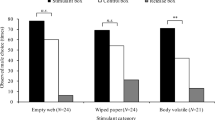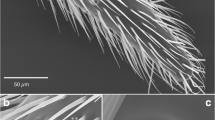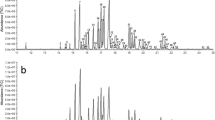Abstract
A synomone present in hexane extracts of corn silks was found to attractOrius insidiosus (Say). The attraction was a diurnal, innate behavior, independant of sex. A portion of the prey-searching behavior ofO. insidiosus apparently relies on olfactory perception when corn is the prey's host.
Similar content being viewed by others
References
Barber, G.W. 1936.Orius insidiosus (Say), an important enemy of the corn earworm.U.S. Dept. Agric. Tech. Bull 504:1–24.
Batholomai, C.W. 1954. Predation of European corn borer eggs by arthropods.J. Econ. Entomol. 2:295–299.
Buttery, R.G., Ling, L.C., andChan, B.G. 1978. Volatiles of corn kernels and husks: possible corn ear worm attractants.J. Agric. Food Chem. 26:866–869.
Buttery, R.G., Ling, L.C., andTeranishi, R. 1980. Volatiles of corn tassels: Possible corn ear worm attractants.J. Agric. Food Chem. 28:771–774.
Cantelo, W.C., andJacobson, M. 1979. Corn silk volatiles attract many pest species of moths.J. Environ. Sci. Health 8:695–707.
Flath, R.A., Forrey, R.R., John, J.O., andChan, B.G. 1978. Volatile components of corn silk (Zeamays L.): PossibleHeliothis zea (Boddie) attractants.J. Agric. Food Chem. 26:1290–1293.
Greany, P.D., andHagen, K.S. 1981. Prey selection, pp. 121–135,in D.A. Nordlund, R.L. Jones, and W.J. Lewis (eds.). Semiochemicals: Their Role in Pest Control. Wiley-Interscience, New York.
Jarvis, J.L., andGuthrie, W.D. 1987. Ecological studies of the European corn borer (Lepidoptera: Pyralidae) in Boone County, Iowa.Environ. Entomol. 16:50–58.
McIndoo, N.E. 1926. An insect olfactometer.J. Econ. Entomol. 19:545–571.
Nordlund, D.A., Lewis, W.J., andGross, H.R., Jr. 1981. Elucidation and employment of semiochemicals in the manipulation of entomophagous insects, pp. 463–475,in E.R. Mitchell (ed.). Management of Insect Pests with Semiochemicals: Concepts and Practice. Plenum Press, New York.
Sokal, R.S., andRohlf, F.J. 1969. Biometry. W.H. Freeman, San Francisco.
Steel, R.G.D., andTorrie, H.T. 1980. Principles and Procedures of Statistics. McGraw-Hill, New York.
Thompson, A.C., Hedin, P.A., Gueldner, R.C., andDavis, F.M. 1974. Corn bud essential oil.Phytochemistry 13:2029–2032.
Author information
Authors and Affiliations
Rights and permissions
About this article
Cite this article
Reid, C.D., Lampman, R.L. Olfactory responses ofOrius insidiosus (Hemiptera: Anthocoridae) to volatiles of corn silks. J Chem Ecol 15, 1109–1115 (1989). https://doi.org/10.1007/BF01014815
Received:
Accepted:
Issue Date:
DOI: https://doi.org/10.1007/BF01014815




